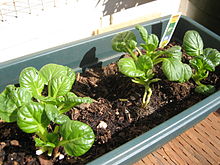Tatsoi
This articleneeds additional citations forverification.(March 2016) |
| Tatsoi | |
|---|---|

| |
| Scientific classification | |
| Kingdom: | |
| (unranked): | |
| (unranked): | |
| (unranked): | |
| Order: | |
| Family: | |
| Genus: | |
| Species: | |
| Subspecies: | B. r.subsp.narinosa
|
| Trinomial name | |
| Brassica rapa subsp. narinosa (L.H.Bailey) Hanelt
| |
| Tatsoi | |||||||||||||||
|---|---|---|---|---|---|---|---|---|---|---|---|---|---|---|---|
| Chinese | Tháp thái | ||||||||||||||
| Literal meaning | drooping vegetable | ||||||||||||||
| |||||||||||||||
| Wu Chinesename | |||||||||||||||
| Chinese | Tháp khỏa thái | ||||||||||||||
| |||||||||||||||
| Yangtze Mandarin Chinesename | |||||||||||||||
| Traditional Chinese | ÔTháp thái | ||||||||||||||
| Simplified Chinese | Ô tháp thái | ||||||||||||||
| Literal meaning | dark drooping vegetable | ||||||||||||||
| |||||||||||||||
Tatsoi(Brassica rapa subsp. narinosa[1]orBrassica rapa var. rosularis[2]) is an Asian variety ofBrassica rapagrown for greens. Also calledtat choy,it is closely related to the more familiarbok choy.This plant has become popular in North American cuisine as well, and is now grown throughout the world.
Naming
[edit]The name comes from Cantonesetaap3 coi3('drooping vegetable'), often renderedtat soiortat choy.However, its natural habitat is not where Cantonese is spoken but alongside theYangtze River,where it is calledthaq-khu-tshe(Tháp khỏa thái) orwūtācài(Ô tháp thái,'dark drooping veggie'). Mandarin borrowed the former name astākēcài.It is also called "Chinese flat cabbage", "rosettebok choy","broadbeaked mustard ",[3]"spoon mustard",[2]or "spinach mustard".
Description
[edit]The plant has dark green spoon-shaped leaves which form a thick rosette. It has a soft creamy texture and has a subtle yet distinctive flavour.
Planting
[edit]It can be grown to harvestable size in 45–50 days, and can withstand temperatures down to –10 °C (15 °F). Tatsoi can even be harvested from under snow.
- Days to Maturity: 45
- When to Sow
- Outside: As early as the soil can be worked. Sow again in late summer or fall.
- Inside: Sow directly outdoors.
- Seed Depth: 1/4 "to 1/2"
- Seed Spacing: 6 "
- Row Spacing: 18 "
- Days to Emerge: 5 - 15
- Thinning: When 4 "tall, thin to 6" apart.
Nutritional value
[edit]Tatsoi contains high levels ofvitamin C,carotenoids,folic acid,calciumandpotassium.[4]
Cooking
[edit]Tatsoi is used for pesto, salads, stir frys and garnishing soup. According to Food52, "Tatsoi is a very versatile green, equally suited to being served raw or lightly cooked. To make it easy, just use tatsoi anywhere you’d use spinach. Lightly steam or sauté it, wilt the leaves with a warm dressing, or add them to a soup at the end of cooking."[5]
The leaves are similar to romaine, while the stalks taste a little like cucumber, with a mild bitterness. Leaves and inner stalk are tender; outer stalk is typically discarded. Typical cooking is to stir fry the leaves and the stalks. They also can be pickled.[6]
References
[edit]- ^Report of a Vegetables Network: Joint Meeting with an Ad Hoc Group on Leafy Vegetables, 22-24 May 2003, Skierniewice, Poland.Rome: Bioversity International. 2005. p. 58.ISBN9789290436799.Retrieved16 March2016.
- ^abCreasy, Rosalind(15 Mar 1999).The Edible Salad Garden.Vermont: Tuttle Publishing. p. 48.ISBN9781462917617.Retrieved16 March2016.
- ^"Sorting Brassica rapa names".Multilingual Multiscript Plant Name Database.The University of Melbourne.Retrieved17 March2016.
- ^"Nutrition Facts for Tatsoi (Spoon Mustard)".HealWithFood.org.Retrieved17 March2016.
- ^Hard, Lindsay-Jean, "Tatsoi Is the New Spinach (Haven't You Heard?) ",Food52, January 28, 2020. Retrieved July 25,2020.
- ^Jay, Ben, "The Serious Eats Field Guide to Asian Greens ",Serious Eats, May 15, 2014. Retrieved July 25,2020.
